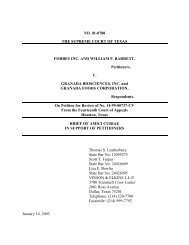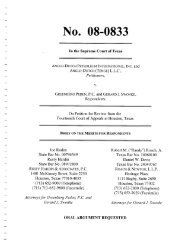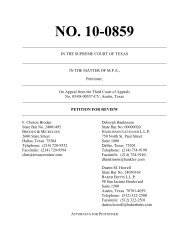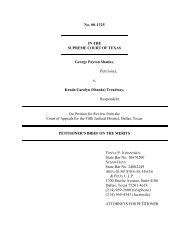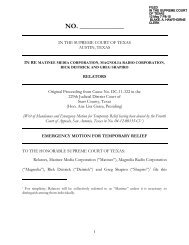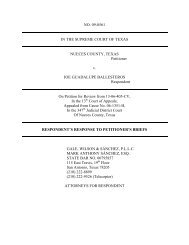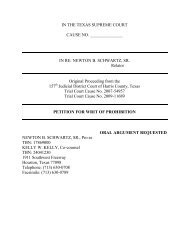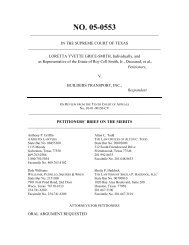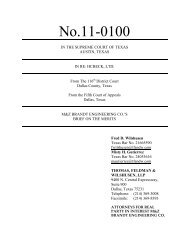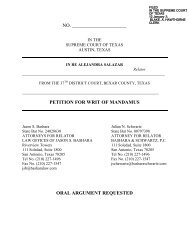DAIMLERCHRYSLER CORPORATION, Petitioner - Supreme Court ...
DAIMLERCHRYSLER CORPORATION, Petitioner - Supreme Court ...
DAIMLERCHRYSLER CORPORATION, Petitioner - Supreme Court ...
Create successful ePaper yourself
Turn your PDF publications into a flip-book with our unique Google optimized e-Paper software.
First, the named plaintiffs are inadequate class representatives because they lack<br />
an even facially cognizable claim. As Texas purchasers asserting “no injury” claims,<br />
named plaintiffs are governed by Texas law.<br />
Texas, like the majority of other<br />
jurisdictions, does not recognize “no injury” claims under any legal theory.* Thus, class<br />
adjudication based on the legally inadequate damage allegations of the named plaintiffs’<br />
claims would drag down the claims of those other purchasers who potentially have viable<br />
claims because they (unlike named plaintiffs) allegedly suffered personal injury, property<br />
damage, or actual out-of-pocket money damages. See State Farm Mut. Auto. Ins. Co. v.<br />
Lopez, 2004 Tex. LEXIS 1249, at *12-*12-*13, *I9 (Tex. Dec. 3,2004) (citing Cuwen v.<br />
Bank United, 70 F.3d 937, 941-42 (7th Cir. 1995) (“A decision that the claim of the<br />
named plaintiffs lacks merit ordinarily . . . disqualifies the named plaintiffs as the proper<br />
class representatives.”)).’<br />
Second, given that a class judgment in this case, which by definition is brought<br />
only on behalf of people who have not been injured, would bar any vehicle owner who<br />
suffers personal injury or property damage in the future from bringing claims based on<br />
the purported design defect in their vehicles, a “no injury” class action is not superior to<br />
While this <strong>Court</strong> has not yet ruled on the “no injury” issue as currently presented, the lower courts of this state<br />
tend to reject the idea that such claims are viable, see, e.g., Gen. Motors Corp. v. Gana, No. 04-03-00702-CV, 2005<br />
Tex. App. LEXIS 532, at *19 (Tex. Ct. App. Jan. 26,2005), and for this reason and the reasons that follow, the<br />
<strong>Court</strong> should clarify Texas law by squarely rejecting “no injury” claims.<br />
’ See Amchem Prods., Inc. v. WindJor, 521 US. 591, 625-27 (1997) (denying certification of class alleging both<br />
risk of injury and manifested injury due to inadequacy of named plaintiffs because “’a class representative must . . .<br />
possess the same interest and suffer the same injury’ as the class members”); Robinson v. SherifofCook Cq., 167<br />
F.3d 1155, 1157-58 (7th Cir. 1999) (“if [named plaintiffs] claim is a clear loser at the time he asks to be made class<br />
representative, then approving him as class representative can only hurt the class”); Ardoin v. Stine Lumber Co., 220<br />
F.R.D. 459, 466-67 (W.D. La. 2004) (‘?t is this disparity of claims that prevents the plaintiffs from meeting the<br />
commonality requirement, and it is the consequences of not recognizing the disparity of these claims that prevents<br />
the class members from adequately representing the class.”); In re Ford Motor Co. Bronco 11 Prod. Liab. Litig., 177<br />
F.R.D. 360, 366-68 (E.D. La. 1997) (“by attempting to tailor their action in such a way as to improve their ability to<br />
establish commonality, class representatives may in fact create an adequacy problem”).<br />
5




